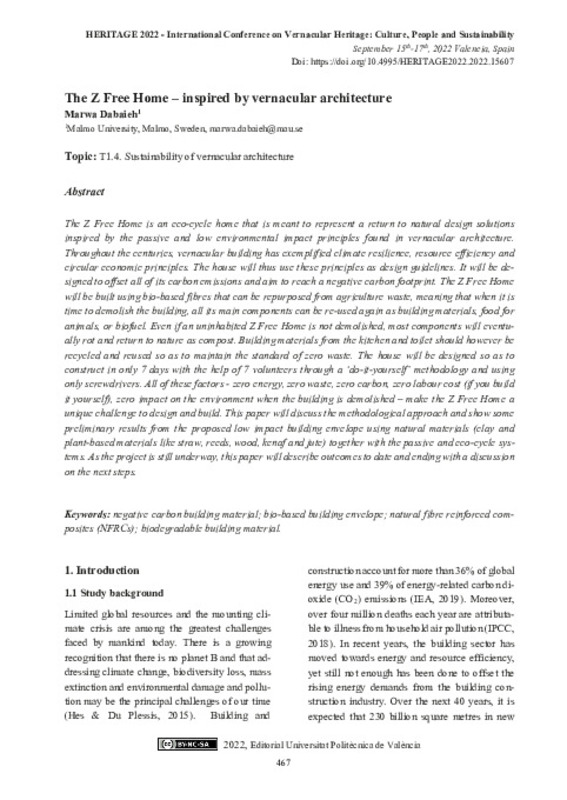JavaScript is disabled for your browser. Some features of this site may not work without it.
Buscar en RiuNet
Listar
Mi cuenta
Estadísticas
Ayuda RiuNet
Admin. UPV
The Z Free Home – inspired by vernacular architecture
Mostrar el registro sencillo del ítem
Ficheros en el ítem
| dc.contributor.author | Dabaieh, Marwa
|
es_ES |
| dc.date.accessioned | 2022-10-27T07:19:59Z | |
| dc.date.available | 2022-10-27T07:19:59Z | |
| dc.date.issued | 2022-09-13 | |
| dc.identifier.isbn | 9788413960203 | |
| dc.identifier.uri | http://hdl.handle.net/10251/188794 | |
| dc.description.abstract | [EN] The Z Free Home is an eco-cycle home that is meant to represent a return to natural design solutions inspired by the passive and low environmental impact principles found in vernacular architecture. Throughout the centuries, vernacular building has exemplified climate resilience, resource efficiency and circular economic principles. The house will thus use these principles as design guidelines. It will be designed to offset all of its carbon emissions and aim to reach a negative carbon footprint. The Z Free Home will be built using bio-based fibres that can be repurposed from agriculture waste, meaning that when it is time to demolish the building, all its main components can be re-used again as building materials, food for animals, or biofuel. Even if an uninhabited Z Free Home is not demolished, most components will eventually rot and return to nature as compost. Building materials from the kitchen and toilet should however be recycled and reused so as to maintain the standard of zero waste. The house will be designed so as to construct in only 7 days with the help of 7 volunteers through a ‘do-it-yourself’ methodology and using only screwdrivers. All of these factors - zero energy, zero waste, zero carbon, zero labour cost (if you build it yourself), zero impact on the environment when the building is demolished – make the Z Free Home a unique challenge to design and build. This paper will discuss the methodological approach and show some preliminary results from the proposed low impact building envelope using natural materials (clay and plant-based materials like straw, reeds, wood, kenaf and jute) together with the passive and eco-cycle systems. As the project is still underway, this paper will describe outcomes to date and ending with a discussion on the next steps. | es_ES |
| dc.format.extent | 7 | es_ES |
| dc.language | Inglés | es_ES |
| dc.publisher | Editorial Universitat Politècnica de València | es_ES |
| dc.relation.ispartof | Proceedings HERITAGE 2022 - International Conference on Vernacular Heritage: Culture, People and Sustainability | |
| dc.rights | Reconocimiento - No comercial - Compartir igual (by-nc-sa) | es_ES |
| dc.subject | Negative carbon building material | es_ES |
| dc.subject | Bio-based building envelope | es_ES |
| dc.subject | Natural fibre reinforced composites (NFRCs) | es_ES |
| dc.subject | Biodegradable building material | es_ES |
| dc.title | The Z Free Home – inspired by vernacular architecture | es_ES |
| dc.type | Capítulo de libro | es_ES |
| dc.type | Comunicación en congreso | es_ES |
| dc.identifier.doi | 10.4995/HERITAGE2022.2022.15607 | |
| dc.rights.accessRights | Abierto | es_ES |
| dc.description.bibliographicCitation | Dabaieh, M. (2022). The Z Free Home – inspired by vernacular architecture. En Proceedings HERITAGE 2022 - International Conference on Vernacular Heritage: Culture, People and Sustainability. Editorial Universitat Politècnica de València. 467-473. https://doi.org/10.4995/HERITAGE2022.2022.15607 | es_ES |
| dc.description.accrualMethod | OCS | es_ES |
| dc.relation.conferencename | HERITAGE2022 International Conference on Vernacular Heritage: Culture, People and Sustainability | es_ES |
| dc.relation.conferencedate | Septiembre 15-17, 2022 | es_ES |
| dc.relation.conferenceplace | Valencia, España | es_ES |
| dc.relation.publisherversion | http://ocs.editorial.upv.es/index.php/HERITAGE/HERITAGE2022/paper/view/15607 | es_ES |
| dc.description.upvformatpinicio | 467 | es_ES |
| dc.description.upvformatpfin | 473 | es_ES |
| dc.type.version | info:eu-repo/semantics/publishedVersion | es_ES |
| dc.relation.pasarela | OCS\15607 | es_ES |
| dc.contributor.funder | Crafoordska Stiftelsen | es_ES |








